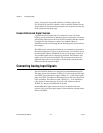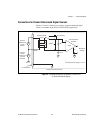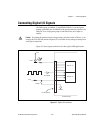
Chapter 4 Connecting Signals
NI 6115/6120 User Manual 4-8 ni.com
source. You must tie the ground reference of a floating signal to the
NI 6115/6120 AI ground to establish a local or onboard reference for the
signal. Otherwise, the measured input signal varies as the source floats out
of the common-mode input range.
Ground-Referenced Signal Sources
A ground-referenced signal source is connected in some way to the
building system ground and is, therefore, already connected to a common
ground point with respect to the NI 6115/6120, assuming that the computer
is plugged into the same power system. Non-isolated outputs of
instruments and devices that plug into the building power system fall into
this category.
The difference in ground potential between two instruments connected to
the same building power system is typically between 1 and 100 mV but can
be much higher if power distribution circuits are not properly connected.
If a grounded signal source is improperly measured, this difference may
appear as an error in the measurement. The connection instructions for
grounded signal sources are designed to eliminate this ground potential
difference from the measured signal.
Connecting Analog Input Signals
The NI 6115/6120 channels are configured as pseudodifferential inputs.
The input signal of each channel, ACH<0..3>+, is tied to the positive input
of its PGIA, and each reference signal, ACH<0..3>–, is tied to the negative
input of its PGIA. The inputs are differential only in the sense that ground
loops are broken. The reference signal, ACH<0..3>–, is not intended to
carry signals of interest but only to provide a DC reference point for
ACH<0..3>+ that may be different from ground.
Pseudodifferential signal connections increase common-mode noise
rejection. They also allow input signals to float within the common-mode
limits of the PGIA.


















